Well, we recently took on the biggest nursery project to date and we lived to tell the tale. This post is a bit of a two-fer, since it not only details how to stain any wooden or veneered piece of furniture but also touches on how to paint anything that’s wood or veneer since we did a two-toned treatment on a dresser that we hunted down on the cheap.
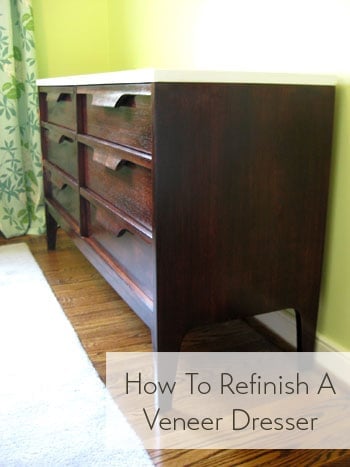
That’s right, we stained our “new” six drawer dresser with a deep rich brown tone and painted the top a crisp and glossy white color. Here’s how it all went down.
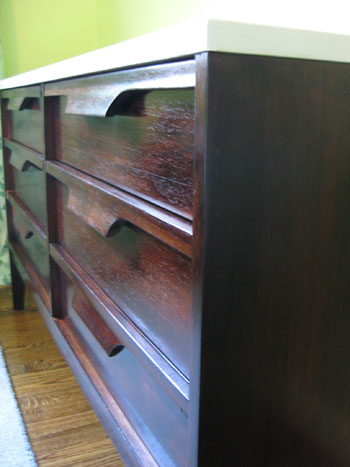
First we had to search for something to add tons of storage space to our tiny-closeted nursery, so we measured the wall that we knew we would be dedicating to a nice double dresser and hopped on Craigslist chanting “less than sixty inches” and crossing our fingers. Our hope was to find something that was up on little legs (so it felt airier and less heavy than a legless version) and we also needed it to be deep enough to accommodate a 17″ wide changing pad since part of the dresser top will also be used as a diapering zone. We had a budget of $150 or less in mind, so we hoped to find something that was a few decades old and solidly made (as opposed to something more flimsy from Ikea circa 2005). We also wanted a piece with nice clean lines to work with our crib which is a bit on the modern side, so a super curvy dresser might feel a little out of place. A few days of stalking Craigslist turned up this listing:
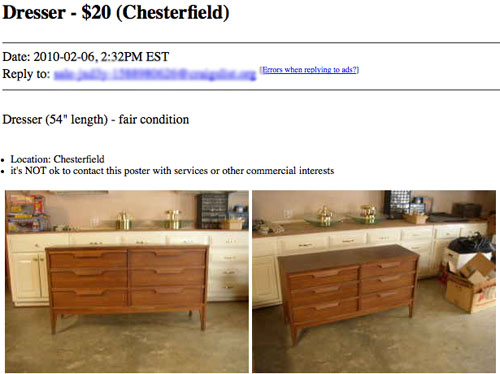
The little legs along with the 54″ length was perfect, plus the clean-lined look of the dresser would work amazingly well with our crib. And did you see that price? Twenty bucks?! Yes please. I said a little prayer to the Craigslist gods and shot off an email right away. Less than three hours later we heard from the dresser’s owner and he said we were first in line if we still wanted it. We just had two more questions: what was the depth of the piece (just to be sure it wasn’t too narrow to accommodate our 17″ changing table pad) and was the dresser made of solid wood (since that’s a lot easier to refinish than something covered in laminate or thin flaking veneer).
The good news was that it was just deep enough for our changing pad. The bad news is that it was veneered (although still extremely solidly made with dovetailed joints, etc). Oh well, it was $20- what did we expect? The verdict: we said we’d love to take a look at it and again found ourselves crossing our fingers (this time in hopes that that the veneer was nice and thick so it could take some sanding and staining). See, the plan had always been to stain the dresser and paint the top a glossy white ever since we got our two toned crib and loved the look. But unlike solid wood, if veneer is too thin it’s pretty hard to sand and restain without going right through it and hitting the plywood underneath during the sanding step.
Luckily when we got there to check out our new Craigslist crush the dresser had amazingly thick veneering (about 1/4th of an inch) which made it easy to determine that we could totally sand it down and restain it without any trouble. Note: to check how thick your veneer is just open a drawer or look at the back of the piece where you’ll hopefully be able to see if it’s paper thin (aka: not-sandable) or thicker than a dime or so (aka: sandable).
Now certain that our dresser hunt was over and this was “IT”, we handed over twenty beans to our nice Craigslist friend and took home our “new” double dresser (thanks to John’s sister’s borrowed SUV- love you Emily!). Then it was time to refinish her. Here she is hanging out on the patio atop a nice big piece of cardboard to catch any stain, paint or primer drips during the muti-phase project:
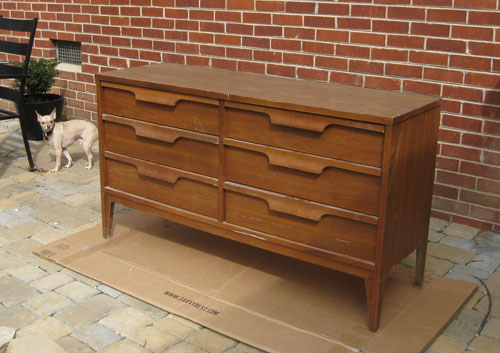
You can see that the veneer is scraped and stained in a few areas and of course the finish isn’t deep and rich like the rest of the wood tones in our house (including the drawer on our new crib in the nursery). Hence the refinishing idea. Oh and it bears mentioning that this little staining & painting tutorial will work for any solid wood items as well as anything that’s veneered as long as the veneering isn’t paper thin. Note: this method is not recommended for any laminate furnishings because that material cannot be successfully stained since it’s not a true layer of wood.
The first thing we did was wipe everything down with a moist rag (both inside the drawers and out) just to remove any spiderwebs, old pen caps & pennies in the drawers, etc. Of course everything was about to get coated in sanding dust again momentarily, but it was a nice “reset” for the dresser and we were able to take things like random paperclips out of the drawers so they didn’t fly around when we got to our big sanding step. Oh and while we wiped things down we came across this label inside the top right drawer:
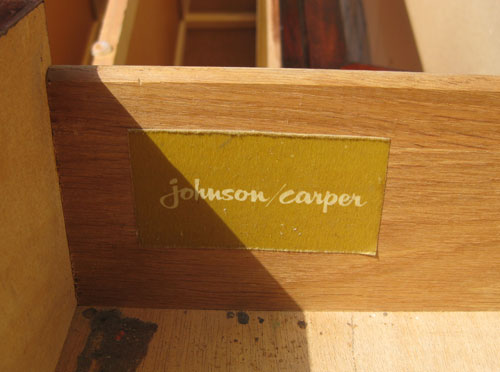
It turns out our twenty beans had scored us an original 50’s or 60’s mid-century dresser. Cool right? We thought so. And that explained why it was so well made and had such nice thick veneering (they just don’t make ’em like they used to). Anyway, the next step was to break out our trusty sander and some extra sandpaper to get to all those crevices that it couldn’t reach by hand. We used 80 grit sandpaper to rough everything up and followed that with another soft sanding with 200 grit paper just to smooth things out. Oh and be sure to always sand WITH the grain of the wood for a nice natural look (nothing screams bad refinishing job like round sander circles that soak up stain and look even more obvious when you’re done).
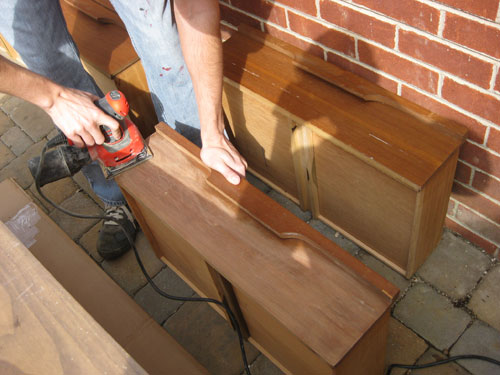
Here’s a shot of our set-up. John got to work sanding the top, sides and front of the dresser along with the flat fronts of the drawers while I was in charge of getting into all the smaller crevices and built-in bentwood drawer pulls where the bulky electric sander couldn’t reach. We also set up a staining station for me to work on drawers on another piece of cardboard nearby (don’t worry, Mrs. Prego wore a mask to avoid inhaling anything nasty).
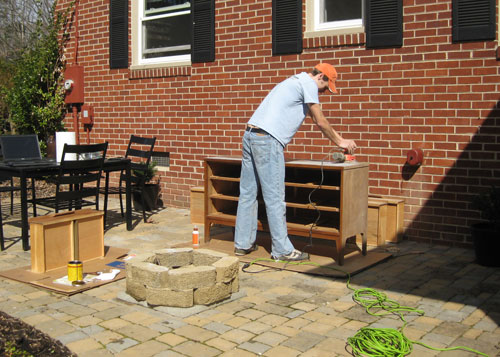
Once things were sanded down with both 80 grit and 200 grit sandpaper (with the grain of the wood) it was time to wipe everything down with a moist rag once again, this time to remove all that sanding dust. Then when things were thoroughly dry (you don’t want to stain a moist recently-wiped down drawer) it was staining time. We picked up a cheap-o synthetic 2″ angled brush (knowing that stain would likely ruin it) along with a pack of rags (which we used to wipe the stain off once we applied it) and a quart of Minwax Wood Finish stain in “Red Mahogany.” Note: we picked our stain color by taking a pretty true-looking photo of the crib drawer with our digital camera and bringing our camera with us to use as a reference while standing there in the stain aisle.

This kind of stain necessitates a coat of poly on top of it to seal everything and add a nice glossy finish but we intentionally opted for it because we knew we could use our eco-friendly Safecoat poly (which is lo-VOC, no-odor and 100% non-toxic… more on that later). We could have chosen to buying a stain with a poly sealer built right in, which is unquestionably the easier approach since it doesn’t call for the extra polying step at the end, but it’s also undeniably more fume-y and chemical-y, especially for something that will live in a nursery.
But it’s definitely worth noting that if you’re looking to take on a staining project and don’t mind the smellier chemicals in the poly-plus-stain-in-one option, just visit your local home improvement store to check out those “shortcut” products (also made by Minwax, although their color palette is a lot more limiting than the ones without poly worked in). We also tend to prefer liquid stain (like the one we chose above) over gel stain because we have more experience working with it, but we’ve heard that gel stain can also be amazing- especially for items that can’t be thoroughly sanded or those on a vertical plane (like wood trim) since the liquid stain can be too runny and messy. So definitely talk to the pros at your local home improvement store or do some preliminary google stain research to pick the right one for the job before you start.
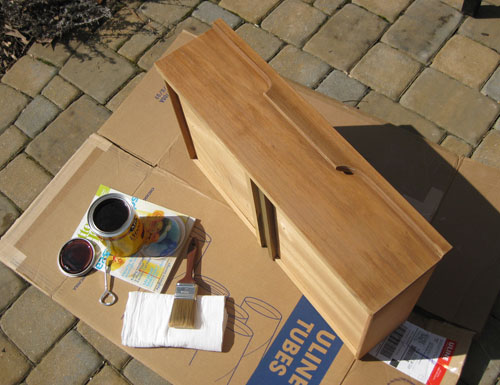
But back to the matter at hand: staining our dresser. After everything was wiped down and dried completely I just used my 2″ brush to apply one thin and even coat of stain WITH the grain of the wood on each surface that I wanted to stain (the fronts of the drawers and the sides and front of the dresser). It went on incredibly smoothly since stain is very watery and the sanded veneer happily soaked it right up. Note: if your wood or veneer isn’t soaking up the stain you probably haven’t sanded it thoroughly enough, so go back and be sure to really sand through the existing poly so the wood underneath can absorb the stain.
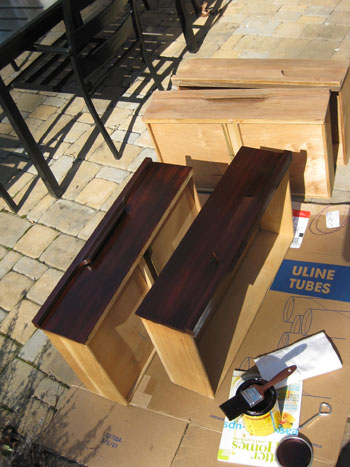
Next we let the thin and even coat of stain sit on every surface that we applied it to for twenty full minutes. We wanted to achieve the richest and deepest absorption possible (which we reasoned would hide the most flaws and leave us with a nice saturated dark tone).
Then after those full twenty minutes we used a clean dry rag to gently rub- again in the direction of the wood- every plane of the dresser that we stained to remove the excess stain. Since we waited so long for ours to soak in we didn’t pull very much stain off at all (our rag was still dark brown but we didn’t see much of a change in tone on the dresser, for which we were extremely grateful). It’s important to remember that you should be gently running the rag along the surface to catch any excess stain but you shouldn’t be applying a lot of pressure (which will result in a streaky and worn down look). Slow and light is the name of the game.
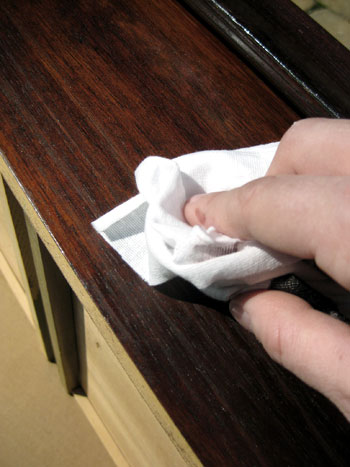
Presto. When you get to this step you have officially stained your item of furniture. In other words, at this point there was a victory dance in progress on our patio. Of course there’s always the option to apply another coat of stain following the same steps outline above (brush on stain, let penetrate for a set amount of minutes, wipe away excess with clean dry rag) if you’d like a deeper or more uniform look. So if you’re left with a piece that is a bit to light or a bit too streaky for your liking we suggest going for a second coat and letting it sit at least 20 to 25 minutes to really soak things up before gently wiping it down again.
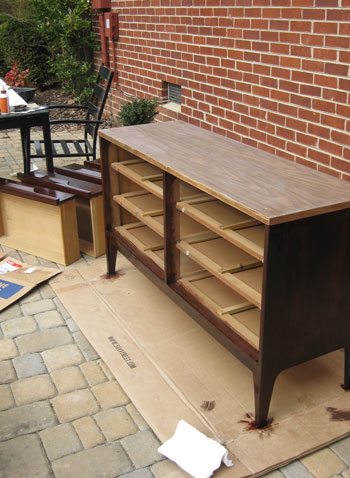
Now on to how we painted the top of the dresser (we’ll get back to polying the stained portion of the piece in a moment). We had already thoroughly sanded the top of the dresser before we began staining so the next step was to apply one thin and even coat of oil-based primer to the top of the dresser with a small foam roller (while being careful not to get any on the recently stained part of the piece). It’s always smart to work out a game plan so you’re not doing a second round of sanding as an afterthought which could result in your stain getting coated with sawdust. And when it came to priming, I was able to use my foam roller to carefully apply primer without getting any on the stained area, but if you don’t have a steady hand you can hold up a rigid piece of cardboard under the lip of the top of the piece to keep primer from getting where you don’t want it.
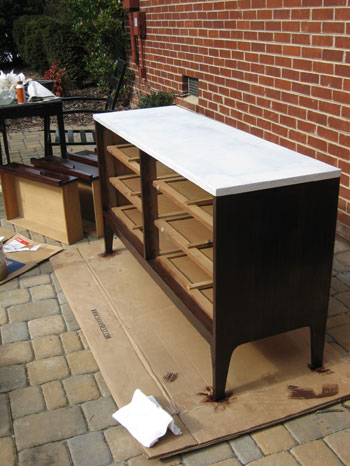
One thin and even coat of oil-based primer should do the trick. The coverage won’t look flawless but it’s there to provide tooth and some nice grip so it’s doing its job as long as everything is coated- even if it looks patchy and thin in some areas while other spots are thicker and less transparent. The reason we suggest oil-based primer over water-based formulas (or primer-&-paint-in-one products) is solely based on personal experience. We’ve attempted to paint furniture with water-based primer and have dealt with bubbling, tackiness, and terrible staining and bleed-through but have never had those problems with the oil-based stuff.
Of course the oil-based formulas are stinky and harder to clean up but it’s worth it to us to do the job right the first time instead of having to do everything over again when something bubbles or bleeds through your water-based coat of primer (which you often don’t see until after your last coat of paint dries- talk about annoying!). And obviously taking precautions like applying the primer in a well ventilated area (we prefer being outside) and even wearing a mask while you work is always recommended. Really, it’s nasty stuff so you want to get ‘er done but be as safe as possible while you’re at it.
The next step was applying three thin and even coats of semi-gloss latex paint with a second small foam roller (remember you can use latex paint over oil-based primer without issue, you just can’t use latex paint over oil-based PAINT since it’ll bubble and separate). We were sure to apply the paint extremely thinly and evenly and not to roll too quickly (which can rile up the paint and cause air bubbles). The white paint that we used is Freshaire’s off-the-rack white semi-gloss paint from Home Depot which is also what we use for all of the trim in our house and many other furniture projects. We love that it’s no-VOC and extremely comparable when it comes to the quality and coverage of other less-eco brands.
Then we just let everything dry for 48 hours (we brought the dresser into the sunroom in case of rain, but kept all the screen doors open for some nice ventilation so the stain and paint were both sure to cure up nice and solidly).

After two full days it was time to coat everything (both the painted top of the dresser and the stained base of the piece) with a nice protective, glossy and totally wipe-able top coat of Safecoat Acrylacq. Of course you can use a cheap and easy to find quart of basic water based polyurethane instead (sold in the same aisle as the Minwax stain) but if you’re not familiar with Safecoat it’s definitely worth checking out. We actually first used it here when we made a bathroom vanity from a night table, and we had most of the quart leftover so we happily used it to seal all that stain and primer/paint for a non-toxic, odor free finished product. Note: we found it at a local green boutique called Ecologic but you might want to google around or even check out greendepot.com to see if you can hunt any down for yourself.
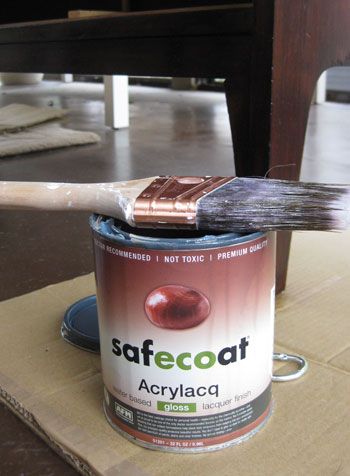
We just applied two thin and even coats of the stuff with a brush (giving it ample drying time in between coats- about five hours or so- to avoid any tackiness or drag marks). You should not get brush strokes if you apply this (or any other water-based poly) very thinly- about as thin as an eggshell or a piece of paper. And you definitely want to brush it on WITH the grain of the wood and gently brush out any bubbles that you see (bubbles can dry and remain forever). The only way you’ll end up with a marred finish or unsightly brush stokes would be if you apply it too thickly or don’t allow an area to thoroughly dry before touching it up again. So gently brush out bubbles as you go and apply very thin even coats, then wait to do a second coat and resist the urge to go over areas that you already did a minute or two before to “clean them up” (because you’ll do more harm than good).
Here are our glorious and glossy drawers drying:
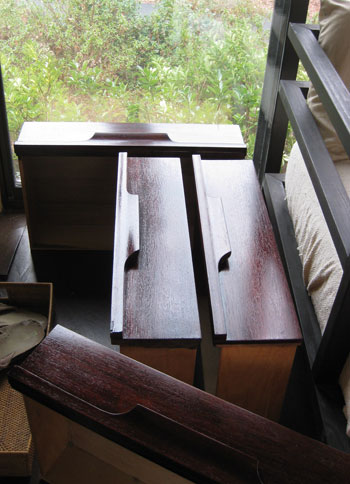
We gave everything three full days to completely cure in our well-ventilated sunroom so by the time we brought the dresser into our nursery over 72 hours later everything was nice and solid so we didn’t have to worry about getting rings on the tabletop if we placed an object on it. Plus everything was 100% odor free and non-toxic thanks to those last coats of Safecoat, so it was nice to walk into the nursery and visit the dresser without smelling it from a mile away. You know how we like to visit our recent projects (we hung out in our recently renovated bathroom for weeks after we finished that big makeover).
So here’s our “after” of a dresser living it up in the nursery:

Isn’t the two-tone finish fun? We think it ties in perfectly with our crib, and it sort of has a kitchen island effect (it’s reminiscent of rich dark cabinets with a glossy white countertop). Plus we love that the entire piece is super protected and wipe-able thanks to the Safecoat, so whether the beanette decides to have a digestive explosion while we change her or throw a wood block at the dresser in a fit of rage, we’re pretty sure it’s up for the challenge.
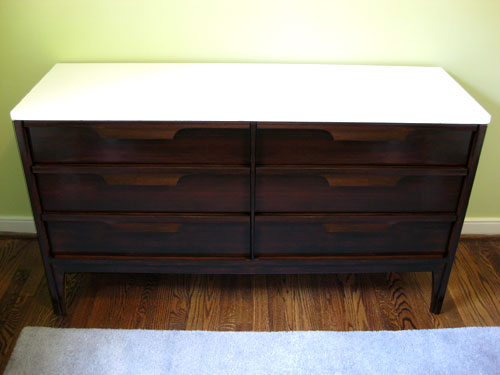
We also love the hardware-free handles since they’re unusual and interesting- and the fact that we get six spacious drawers for storing everything from clothes and diapers to books and toys is really the icing on the cake.

Oh and we know you guys love a budget breakdown, so here you go:
- Dresser: $20 from Craigslist
- Sandpaper: already owned (80 grit and 200 grit)
- Electric Sander: already owned – it’s by Black & Decker from Home Depot for around $50)
- Stain: $7.02 (Minwax Wood Finish stain in “Red Mahogany” from Home Depot)
- Ten cloth rags: $2
- Cheap synthetic brush for stain: $2.49
- Two small foam rollers for primer/paint: already owned
- Oil-based primer: already owned
- Freshaire White Semi-Gloss paint: already owned
- Safecoat: already owned
- TOTAL: $31.51
Not bad right? We totally expected to come in around $175 because our original budget was $150 for a large super-solid double dresser from Craigslist and we knew we’d need some supplies. But our budgetary surplus just means that we have more money leftover for a few other fun nursery projects (we still have art, DIY shelving, a homemade mobile, closet organization and lots more on the agenda). Oh and we actually have a second dresser project to share a little later in the week (lets just say we had the time of our lives lining the drawers so we’ll be back with those details). Stay tuned…
And while we’re on the subject of staining and painting furniture, have you guys taken on any big makeovers of your own? We’d love to hear what you’ve been up to. And since we also owe this dresser makeover to Craigslist for supplying this beauty (we still can’t believe it’s an original 50’s or 60’s dresser) feel free to tell us all about any and all recent Craigslist finds that you guys have snagged. Fun, fun, fun.
Psst: Wanna see our nursery progress from the very beginning? Here’s our painting post, our big shopping spree, our crib hunting rundown, our curtain-making tutorial, and our fun little chair search, our mirror-painting extravaganza, and our DIY faux sheepskin project.
Update: We finally created this Shop Our House page to help you hunt down any furniture/accessories that you see in our house, along with all of our paint colors.

Alissa says
Your tutorials make me want to tackle projects! I’m thinking of getting a Craigslist hutch for our dining room and staining darker it to match our table. We live in Virginia and it’s cold and icy right now, as you probably know… :) Should I wait for this outdoor-ish project until the weather gets nicer? Is it possible to refinish in a cold garage without getting bubbles in the stain or anything? Thanks so much!!
YoungHouseLove says
Hey Alissa,
Good question! We’ve never done it in this type of weather, but we hope to stain a rocking chair soon so we’ll definitely share how it works out! You can read on the label if it’s supposed to be above a certain temperature, and we might even go for it if it’s not- just to see what happens! Here’s hoping we get to that soon!
xo,
s
Erin says
Thanks so much !
You saved me alot of time and worry …..been doing a re-do on the bedroom/bathroom for my man while he is on a trip and I was running out of time ! You guys are awsome !
Erin says
We’re in the process of furnishing our nursery for our very first little bean or beannette, and we’re trying to decide whether to get a three drawer or six drawer dresser. Baby/toddler clothes are so small, but on the other hand we have nonexistent closet space. Any thoughts?
YoungHouseLove says
Hmm, I’d lean towards six instead of three if you can swing it. Having more delineation between socks and diapering supplies and shirts and pants and pjs and onesies always helps. Good luck with you wee one on the way!
xo,
s
Lauren F says
Hi!
My husband and I received a hand-me-down dresser/changing table for our baby-to-be, and we want to restain it in a rich, cinnamon color to match our crib (the dresser is now a light honey color). It is solid wood and definitely has some sort of lacquer/poly finish on it. Every other site I’ve looked at recommends using a stripper to remove the finish before sanding and restaining. Do you think that this is an unnecessary step? Were the low- and high-grit sandings enough? Your dresser didn’t look uber-shiny to begin with, so I’m curious to hear your opinion/recommendations.
Thanks!!
YoungHouseLove says
We like avoiding chemicals whenever possible (especially if you’re prego and it’ll go in a nursery) so we’d recommend a thorough sanding outside with a hand sander (wear a mask if you’re doing it- just to be safe). That usually does the trick (we’ve never had to use a chemical stripping agent- ever- and we refinish lots of things!). If you do end up needing one, just make sure you don’t apply it and it totally dries before you bring it into the nursery!
xo,
s
Nikki G says
Quick question: You guys inspired my husband and I to refinish a dresser for our nursery, and we’re almost to the last step. We just have to add the safecoat poly and are wondering if you sanded before the first coat, and/or between coats? I don’t see mention of it in your tutorial, but the hubs said that’s what the directions on the can indicated. I’m afraid if he sands before the first coat of poly it’ll ruin the stain… Thanks so much if you’re able to answer!!
YoungHouseLove says
We didn’t sand before or during the safecoat applications since we always apply super thin coats as we go (sanding smooths out drips, but they can be totally avoided if you go slow and steady and apply paper thin coats that thoroughly dry before the next one). Hope it helps!
xo,
s
Nikki G says
Ahh… okay :) Thanks for the reply!!
YoungHouseLove says
Sure- good luck!
xo,
s
Rachael says
In Australia Home Beautiful, a mid-century chest just like yours (but with an extra column of drawers) was for sale for $1100 at http://www.retromodern.com.au, crazy!
YoungHouseLove says
Woah! That’s fancy!
xo,
s
Liz K says
Hi, I apologize if someone already asked this question – I’ve always been nervous about putting on a polyurethane topcoat, because everything I read says something along the lines of “Don’t let a speck of dust get on it or the finish will be ruined.” Not living in a lab, I couldn’t figure out how to accomplish this. But it sounds like a reasonably clean area is fine for painting a nice durable surface on??
Thanks for all the help I’ve been getting from reading your website!
YoungHouseLove says
We actually put our poly on outside, which has lots of stuff blowing around in the air but it was just fine! It’s only really tacky for a short while (especially if you put on really thin coats that dry right away) so that’s the way to go. Good luck!
xo,
s
Trish says
I’ve seen this dresser like 3 times now and am so in love with it. Major midcentury mod junkie and only now read that you got it for $20. SO JEALOUS.
Larissa Peitsch says
Hi you two!
Writing all the way from Winnipeg, Manitoba, Canada…first of all, I love your blog and so do all my friends! Second, love the dresser that you refinished for Clara’s room! I hope to do something very similar for our new little boy’s room (he is brand new, only 3 weeks old now), but have a quick question for you both before I tackle the project.
When applying the polyurethane to the top of the dresser (the white portion), do you apply it with a foam roller to get the same finish or with a brush?
Thank you in advance for your help!
Larissa
YoungHouseLove says
We brushed on super thin coats. But you can roll it on as well. Just be sure to keep them thin.
xo,
s
Sarah says
What oil based primer did you use when you were pregnant? Is it VOC free?
YoungHouseLove says
Sadly oil-based primer is never VOC free (but anything water based that is can result in bleed-through) which is why I used my industrial strength gas mask (not one of those paper ones, a real one from the hardware store with a filter) and did all of the painting outside just to be super safe. Hope it helps!
xo,
s
Linda says
Beautiful dresser! Awesome website! I was wondering do you recommend trying to paint a particle board dresser? If so, should I sand at all or just use a primer? Am I kidding myself? lol Thanks!
YoungHouseLove says
That’s usually tricky (since it’s not porous like wood so it doesn’t have the same long lasting results sometimes). The best method we’ve seen is usually sanding, priming with oil-based primer, and painting with latex paint. Remember to apply very thin layers (using a small foam roller can help). Good luck!
xo,
s
Kylee says
Hi Sherry,
Would you be able to share the post with me about how you attached the changing pad. I searched for it but can’t seem to come up with all the details about how you secured it etc.
Thanks!
YoungHouseLove says
Here’s a post full of info for ya (you have to scroll down a bit to get to it): https://www.younghouselove.com/2010/03/nursery-progress-makin-a-mobile/
Hope it helps!
xo,
s
Heather says
I’ve stumbled upon your site during my research about staining. I have chosen Minwax but also picked up an expensive brush and Odorless Mineral Spirits to clean it. You’ve chosen to use an inexpensive brush, so do you discard it after the project? Also do you use a new brush for the sealer? Thanks!
YoungHouseLove says
It really depends (sometimes I’ll use a great brush and clean it with mineral spirits and sometimes I’ll just use cheap $1 brushes and discard them afterwards). Either can work, just really clean a good brush well after using it with stain or poly, otherwise it’s ruined. Good luck!
xo,
s
Stephanie W says
This might be a novice question, but what kind of sander did you use for this?
I just picked up a dresser very similar to yours on craigslist for FREE! It was painted this ugly cream color that is chipping in places and I want to sand it down to the wood and paint it white for my future nursery. Any advice on how to do that sanding would be great!
Thanks!
YoungHouseLove says
We have a little hand sander by Black & Decker (got it at Home Depot for about $30).
xo,
S
Amanda says
I know it’s been a while since this posted, but I had a question about how you polyurethaned the top of the dresser. We tried this with our daughter’s nursery furniture (painted it white) and the poly turned the white yellow. We resanded and painted again without poly, but now it scuffs easily.
YoungHouseLove says
It really depends on the type of poly you use (many tend to yellow but the one mentioned here by name and Safecoat Acrylaq don’t have that problem if applied thinly and evenly). Hope it helps!
xo,
s
Heather says
Unbelievable! I have this exact same dresser which we too are using in the nursery as a changing table. We also have the matching taller dresser. They are in great shape considering my parents bought the bedroom set sometime in the late 60s maybe? and I’ve moved them from place to place in the last 15 years. I wasn’t sure about staining with the veneer but I’m happy & excited to see the potential! I’m even happier that I noticed the transformation pic/ad on babycenter.com!
YoungHouseLove says
That’s so funny! What a small world.
xo,
s
Cayla says
Question then… is there a way to refinishi IKEA furniture?Can it be painted if it already comes in a color? I.E We have a TON of the “black brown” color of Ikea furniture…. Thanks!
YoungHouseLove says
The problem with Ikea furniture is that it’s laminate and not veneer. But this laminate painting tutorial might help: http://livingwithlindsay.com/2009/05/how-to-paint-laminate-furniture.html
xo,
s
Messy says
HI John, Sherry
I would like to know the height of the dresser?
Am looking for a dresser myself to be used as a diapering zone like you did.
WxHxL would be appreciated
thanks
YoungHouseLove says
It’s 54″ wide x 18″ tall x 30″ high. Hope it helps!
xo,
s
Elizabeth says
Hi – I love your website! I’m currently transforming our home office/2nd bedroom into a nursery. I was planning on moving a dresser we already have into the nursery, but I realized that what we have is, in fact, the dreaded Ikea dresser circa 2005, haha. It’s solid pine except for fiberboard drawer bottoms and fiberboard back. I’d love to use it in order to save some money and to avoid having to buy more furniture for our already small apartment, but I know there are concerns about formaldehyde in fiberboard. Do you have any suggestions for replacing the fiberboard with something safer?
YoungHouseLove says
I would just seal that fiberboard with Safecoat! Just google around or call their number to see which specific product you should use, but it can block offgassing (you just brush it onto the fiberboard with a brush and let it dry and it’s non-toxic and sealed! Good luck!
xo,
s
jill says
I love the dresser! I’ve been looking around your blog trying to find out if you mention anywhere about brush lines in furniture. I read how you do your painting and will definately be following your instuctions but I have brush lines that I don’t want! I danced down the first coat to try to smooth it out and did a thin second coat and it still happened. I want to put a gloss finish on but I am afraid it will make it look worse! Should I sand again and try again? HELP!! I feel like I’m wasting my time and I don’t want to get discouraged from doing other projects like this. Thanks so much! I think you guys are awesome!
YoungHouseLove says
I would sand it smooth and then use a small foam roller. No brush strokes. Just be sure to get it on thinly and not glob it on. Good luck!
xo,
s
Anne Marie says
I’m working on a similar project for my baby’s nursery. The dresser has been stripped and stained. It has been sitting in my garage for a three days. The SafeCoat has been purchased, but I’m not sure if the stain is “ready” or dry. The wet spots are gone, but if I run a paper towel on the piece, I still get some stain on it. The guy at the paint store said that darker stains take longer to set…any advice? I don’t want to poly just to ruin it and have to start all over again. Thanks!
YoungHouseLove says
You should definitely be good to seal after three days (sometimes unsealed stain rubs off on things forever until you seal it). Just be sure that you rubbed your stain off with a rag like in this post when you applied it. If not go over the whole piece with a rag now to remove excess. Then you’re good to poly. Good luck!
xo,
s
Anne Marie says
Just an FYI. I used a Minwax stain on my dresser, rubbed off the stain with an old t-shirt, and let it sit for several days. After I applied the SafeCoat, it started to bubble…it went on smooth but then began to bubble. I called the company that I bought it from, and he said that water-based poly on top of oil-based stain only works 70% of the time. He told me that I need to sand off the poly, wash the dresser with soap and water to remove the surface oils, and test poly a small area. Hopefully this works!
YoungHouseLove says
Woah- never heard of that! We’ve used SafeCoat on a ton of projects with Minwax under it (this dresser, our living room console, etc) so we’re really surprised to hear that. So sorry for all the trouble and good luck!
xo,
s
Landy says
Ok, I know this is an old post now, but I have a question, if you’re willing. I’m starting to think about the nursery (only 6.5 months before the baby’s here–better hurry, right?). Rather than spend money on a changing table, I decided to follow your lead and get an old solid dresser. I found one for $40 on Craigslist and picked it up yesterday. It’s nice and sturdy, and I think most of the wear and damage is just to the finish (which is old and crackle-y). This dresser has more detailing than the one you refinished though–how would you suggest removing the finish? I’m not super-keen on using stripper while pregnant, but I don’t really know how to sand the little carved areas very well either. (There aren’t a ton of intricate carvings, but the legs are spindles and the drawers have a little router-ed out edging around them). Would you suggest a Dremel tool for sanding? I haven’t decided whether to paint the whole thing white (probably easier) or to stain it, but if I stain it, I’m really going to need the finish gone entirely. Any thoughts/suggestions? (And thank you for the inspiration–hopefully, this will be far nicer and more sentimental than just purchasing a brand-new, cheap changing table). Thanks!
YoungHouseLove says
I would just fold a piece of sandpaper up and try to use it kind of like a pencil to get into the cracks as well as possible. A dremmel wouldn’t hurt but might not be necessary (as long as you rough things up for stain to penetrate you should be ok. And if you’re painting it that’s even easier since primer and paint should go right over that area without any sanding (so you could even skip that step if it’s too hard to sand that ornate area). Good luck!
xo,
s
Kirin says
Just wanted to say thank you for a great tutorial–I used it as my jumping off point for sanding my own mid-century dresser from Craigslist (I made a few modifications since my veneer was much thinner and the dresser had a laminate top). Anyways, I definitely wouldn’t have been able to tackle this project without pulling inspiration from you, so thank you much! If you want to check out my version, you can see it here:
http://bunchesofjoy.com/2011/07/07/project-1-refinishing-a-thinly-veneered-dresser/
YoungHouseLove says
That looks AMAZING! Wow- great job!
xo,
s
Greg says
Hey guys, brand new to your blog (and DIY…home related that is) and it’s awesome! My question is would you use the same technique for refinishing and painting a crib? Our first is due in 4 weeks and I’m curious if you’ve used the zero-VOC version of KILZ to block bleed through (like the one that finally worked on your wood paneling) on furniture and would be better choice for a crib than oil based primer? Also, having trouble tracking down the Safecoat Acrylacq in my area (Upstate, SC), do you know of any chains that carry or would Minwax Poly semi-gloss be a good choice?
YoungHouseLove says
I would definitely use that no-VOC Kilz since it’s available now (although theoretically, the Safecoat should block and offgassing from beneath it, but it can’t hurt to use no-VOC stuff whenever possible!). As for the SafeCoat Acrylacq, I would order it online instead of using Minwax Poly. That stuff is high VOC and it can offgas for a number of years! Hope it helps!
xo,
s
Nadia says
Hello from Montreal :)
all your blog is awesome
I love it!! thanks for sharing so many nice tips with us, its really great and appreciated
and I really love all the things you do, all your house looks lovely :)
I would like to know why you used safecoat instead of Minwax polycrylic water based clear gloss
isnt this one VOC free too ??
YoungHouseLove says
Nope, only the SafeCoat is low VOC and non toxic. Hope it helps!
xo,
s
Nadia says
yes thank you :)
Ellen Justice says
I have a quick question, and I’m sure it may have been answered somewhere, but I can’t find it! :) I’m currently redoing a good bit of furniture for my new house (yay!), and part of that is my kitchen table. It had a light wood top with a stain finish that made the wood look more yellow than the pretty light color that it naturally is, but I’ve sanded it to the natural wood so far. Is there a stain or something of the sorts that I can use to keep the pretty light wood look of the table? I basically just want a clear coat of something to protect the wood (i.e. I’d like to be able to put glasses on it without coasters). I saw you recommend Minwax water-based polycrylic protective finish in clear gloss as a top coat on your table and chairs for the sun room, but I wasn’t sure if I would need something under that on the wood first? Am I making sense? lol
YoungHouseLove says
There are all sorts of rich lighter stains that you can use (I would head to your local home improvement store and just see what they have). Some are completely clear and also do the sealing, and some are a lightly toned to add some natural rich color while they seal things. Just be sure to get something that has a built in sealer or the additional sealer they recommend on the stain can (some other poly brands can “react” poorly to certain stains). Good luck!
xo,
s
jen says
I am so frustrated. I bought a vintage dresser to redo for our soon to be arriving baby a few months ago. The initial plan was to stain it, but after sanding (outside in the summer 7 months pregnant) it turned out that the wood veneer was a bit too thin to stain. So we used this and your other furniture painting tutorial. The first time I used kilz VOC latex primer instead of oil based primer because I was trying to tackle this project alone and my husband is very busy redoing our master bath. When I went to lowe’s to get some olympic home premium the paint guy accidentally gave me exterior paint. I didn’t realize this until I finished the first thin coat and it was a weird waxy finish. A scratch test a couple days later took off the paint AND primer so I started from square one again sanded the beast all the way down again. I got my husband to prime it the second time with oil based primer, let it off-gas for several days then applied 3 extremely thin coats of the correct interior olympic home premium paint, spaced a minimum of 12 hours apart. After letting them cure for a full week I moved the drawers into another room to be clear coated. 2 drawers got gently scooted too close to each other pre-clear coating and immediately peeled. During an attempt to fix this, sanding proved to peel the paint as well. The oil based primer sticks to the wood perfectly but the paint peels easily off of it. I am SO frustrated… with all the extra time I’ve given it to cure, I’m now due in 2-3 weeks and just want to throw it away. Incidentally, we’ve been having a lot of paint issues in the last few months with a few different brands of paint (even a $50 can of sherwin williams) and an feeling totally DIY defeated. If anyone can offer suggestions…. PLEASE PLEASE HELP! – also we are painting indoors in ~ 78 F AC. So humidity and temp should be fine! Gonna go cry now…. please help.
YoungHouseLove says
Oh man, I feel your pain! So sorry for all the issues. My only guess is maybe it’s laminate furniture instead of veneer? That always seems to scratch and peel, even with oil-based primer. Maybe bring a drawer to a paint store (Benjamin Moore folks are usually very knowledgeable) to see what they recommend? Good luck!
xo,
s
jen says
Sorry for the pregnancy induced painting meltdown above! The dresser is wood veneer, not laminate, so I have no idea why we have had so much trouble. My husband stepped in this afternoon and sanded some of the drawers down to the wood and painted them with NO primer…. the paint seems to have adhered better to the wood, even after multiple coats (he is less much careful than me about curing times… and everything really). It’s so weird!
YoungHouseLove says
So glad you figured something out! Whew.
xo,
s
Maddie says
I’m using your awesome tutorial on a mirror with a wooden frame. Unfortunately, my one coat of stain hasn’t seemed to dry completely, even after 48 hours. I didn’t layer the stain on eggshell-thin, but was careful not to be excessive—and wiped it down very gently afterwards, as you recommended. I definitely sanded it enough before starting, too. What did I do wrong? Do I have to sand it and start over (please say no), or is it safe to apply the poly, even though the stain feels slightly tacky?
Thanks in advance! You guys are the best.
YoungHouseLove says
Hmm, I would just use a clean non-fuzzy cloth to rub it down firmly (to lift off any excess stain) and then wait another day if it’s still a bit tacky. Then I’d just apply that poly (super thinly with drying time between coats) and give it a few more days to see if it’s cured up. Good luck!
xo,
s
Maddie says
Thanks, Sherry! Wiping the stain a second time helped a lot, but the surface of the wood still felt tacky. So I crossed my fingers and scrubbed it down again using a small amount of rubbing alcohol—which actually worked! The first coat of poly just dried without issue. Thanks for your encouragement!
YoungHouseLove says
Wahoo! So glad!
xo,
s
Noel says
I’m so sorry to ask this again, but did you use water or oil based stain? I read through the comments and it sounds like it was water based, but I got confused because something else was oil based- the primer, I think? We’re in the middle of refinishing an old desk and we’re not very experienced at this yet!
Do you think it’s safe to use Safecoat inside? The only “ventilation” I would have is an open door and central air, but the weather is just not cooperating this week (I know it’s probably better not to risk it, I’m just limited on time). Hopefully I’ll have a nice before/after picture to post on your Facebook page soon!
YoungHouseLove says
I believe the stuff in the yellow can that we used (Minwax Wood Finish) is oil-based – just go to Home Depot or Lowe’s and look for the yellow can since that’s pretty much the standard stuff for staining (although a more eco water-based version would be awesome if you can track it down). I would definitely try to apply that outside if you can (although the Safecoat stuff is fine to do inside since it’s low-VOC and non-toxic – especially if you open the door and run the air and have a fan going if you can). Good luck!
xo,
s
Noel says
Thanks, Sherry!
Rupa says
Hi Sherry!
Beautiful job. I am pregnant with my second boy now and am planning on repainting some craigslist finds for my son’s new big boy room. I was just wondering if there was an oil based primer which you used during pregnancy that was low voc? Or did you just wear a mask and work outside? We live in Hawaii so the working outside part is not too hard!
Thanks !
YoungHouseLove says
I did actually wear a gas mask and work outside (not a paper mask, a real gas mask from the home improvement store – it was around $30 I think). I wish they made no-VOC oil-based primer but I think anything with oil-paint has VOCs. Although the Kilz no-VOC primer that we used to paint our paneling might be worth trying (you might have annoying bleed through issues though, which don’t happen with oil-based paint).
xo,
s
Nico H. says
I am looking to do the exact same thing to my dresser. Thanks for the great tips.
Erin says
Totally saw your nursery in American Baby and was immediately overcome with nursery envy. I’m refinishing a crib and a changing table this fall. ehow.com had a really great article on dealing with refinishing wood laminate. Since I suspect that our crib has wood laminate I will let you know how it goes…
In any case beautiful job! my project after nursery is to redo the bedroom set I inherited from my grandparents.
YoungHouseLove says
Aw thanks so much! Good luck with your project! Definitely let us know how it goes!
xo,
s
Meaghan says
Hi guys,
Loved your dresser so much that I did the same with a very similar one we inherited. You’re a great source of inspiration :)
http://diybymrc.blogspot.com/2011/07/refinishing-wood-dresser.html
Meaghan
YoungHouseLove says
Wow- that’s gorgeous!
xo,
s
Natalie says
We have the same brand of dress and it looks very similarly. However, we are wanting to stain the entire dresser once sanded. Once you removed the veneer, do you think you could have stained the top? We want to go with a light colored stain.
YoungHouseLove says
Oh yes, you can easily stain the top instead of painting it. Just don’t remove the veneer- only sand it! If you remove it you’ll just have ugly fiberboard under it! Just sand it enough to get through the sealer and try to restain it all over without going too deep. Good luck!
xo,
s
april says
Hi there – I just found your wonderful post, AFTER I ruined an oak bathroom cabinet today by not sanding it well before staining. I rushed through the sanding step, then used a dark stain, and now it has circular dark spots, some spots didn’t accept the stain at all. It looks terrible! I haven’t coated it with poly yet. After it dries fully can I just cut my losses, put on a primer and paint it black? Thanks so much for your help!!
YoungHouseLove says
If you wanted, you could wait for it to dry and sand it more deeply and then restain it, or you could prime and paint it (which is usually the more foolproof process if you’re worried). Good luck!
xo,
s
april says
Thanks for the response – should I try to sand off the stain before priming it? And since it was oil-based stain, do I need to use an oil based primer and paint?
YoungHouseLove says
I would sand it smooth at least and then use an oil-based primer followed by latex paint. The oil-based primer will block bleed through. Good luck!
xo,
s
candace says
I’m considering re doing our kitchen cabinets in a deep stain (the color of your re done dresser). Currently they are stainined wiht a light pine tone. Any tips / directions?????
YoungHouseLove says
I think Katie Bower over at bowerpowerblog.com did that in her first house- maybe look for a tutorial?
xo,
s
Ryan says
Did you guys lightly sand the dresser in-between coats of Safecoat? The Minwax water based poly can says to do this but it makes me nervous that the sanding will ruin the protective seal. Any suggestions?
YoungHouseLove says
We didn’t because we like to apply it soo paper thin that it doesn’t have drips or anything to sand. But if yours is thick and bumpy sanding it can help smooth it out. If you put it on super thin, you should be ok without sanding!
xo,
s
Jill says
My husband and I came across your blog while googling for instructions on how to do exactly what you describe…sanding and staining a dresser for a nursery. Since we loved your results (and detailed instructions) so much, we also chose the Red Mahogany Minwax stain and the Safecoat Acrylacq lacquer gloss. However, when I purchased the Acrylacq today, the person who helped me said that since the Acrylacq is water-based to make sure the stain we were using was water-based and not oil-based, as it wouldn’t work over oil-based stain. I couldn’t remember what the Minwax was so I just bought the Acrylacq. When I got home, I realized the Minwax stain was indeed oil-based, but it doesn’t seem to me that you guys had any trouble mixing the two. We aren’t doing the two-toned look so we’re not painting at all, just staining and lacquering (if that’s a word). Can you advise? Thanks!
YoungHouseLove says
I would do a test on an inconspicuous spot (the bottom back of the leg for example) and see how it goes! We’ve never had any issue using it over Minwax stain or paint of any kind- it’s always smart to do a little test just to be sure though. Good luck!
xo,
s
Tonya says
I am searching the web or tutorials to complete my first make over project. I would have never thought to paint the top white! That gives it a very modern feel. The dresser I ma painting is already white and I am wanting to do a cherry wood stain on it!
At any rate, thanks for sharing. Awesome Tut!!
Melizza says
Amazing results. I can’t wait to live in a house again (currently in an apartment) so I can work projects like this.
Best criagslist find? My husband! We celebrated our second anniversary yesterday. My second best find? Our wedding photographer. I have never had a bad craigslist experience *knocks on wood*.
Beatrice says
I have been going through all the projects hoping to find the refinishing answer I was looking for (in my book, if you guys haven’t tried it, I am not doing it!) and the only refinishing I saw was the sweet dresser… but my new (old) harvest table is a pine affair that was just varnished sometime in the past… Hubby voted against painting it (I would paint anything) and wants to stain it a dark rick espresso. All good but from the little I know pine does not take well to stain. What do you and the other readers think? Has anyone stained pine anything and how did it work out?
Thanks for the help in advance, we are totally stumped!
YoungHouseLove says
We’ve stained whitewood/pine wood when building things like our console table and our desk and it looks great! Is there any way you can do a stain test on the back or underside of it to see how you like it? Might help you decide what to do. Good luck!
xo,
s
Angela L says
Love this! We have a very similiar dresser and two nightstand set that could use a little stain love.
So, its stupid question time – my handheld sander is an orbital, I’m assuming that will make those ugly circle sanding marks by not going with the grain as you mentioned? Do I really have to take on all three pieces by hand? Yikes!
YoungHouseLove says
I would probably spend around $20 on a mouse sander to get those done about ten times faster! It breaks down to around $7 per furnishing and I’m guessing it might be the best money you spend! Good luck!
xo,
s
Jamie Shehan says
Did you sand like the instructions say between each poly coat?
YoungHouseLove says
I apply it paper thin, so I didn’t have any drips or bumps to sand out. It never hurts, but if you apply things super thin and even it might not be necessary. Hope it helps!
xo,
s
Lis says
I don’t know if this has been answered yet, but any tips on how thin is too thin on veneers for sanding? I have two similiar dressers/hutches that I would LOVE to do this to, but I’m not sure just how much wood is enough!
Thanks :)
YoungHouseLove says
Most veneer in order to be applied has to be thick enough to allow for a small amount of sanding so I would just rough it up a bit with sandpaper and you should be ok!
xo,
s
China Alesse says
Wow i am very amazed how easy it is. I had purchased stain to refinish a table and chickened out. Thanks i will now attempt to do it on my own.
Nikki says
It looks great, I did the opposite effect. Stained on top, painted on the bottom.
http://www.twolooniesandapenny.blogspot.com/2012/02/refinishing-nursery-dressers.html
YoungHouseLove says
Gorgeous!
xo,
s